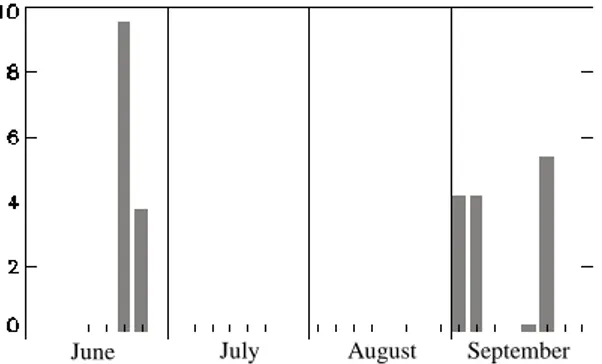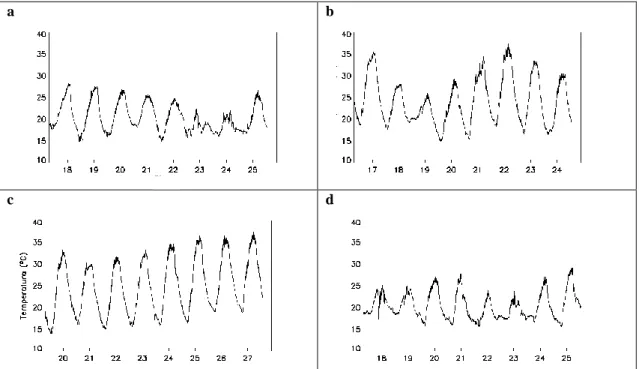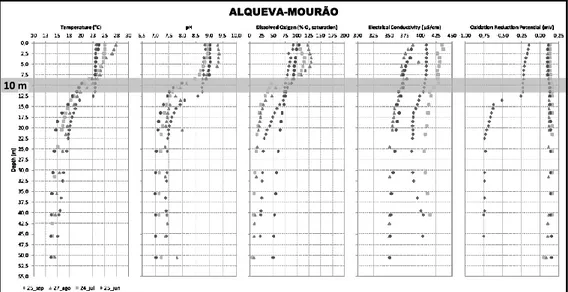ALQUEVA
HYDRO-METEOROLOGICAL
EXPERIMENT
(ALEX): FIRST RESULTS OF AQUATIC ECOLOGICAL
ASSESSMENT
Maria Helena Novais, Maria Manuela Morais, Susana Nunes, Joana Rosado, Alexandra
Penha, Amely Zavattieri, Miguel Potes, Rui Salgado
Instituto Ciências da Terra (ICT), Pólo da Universidade de Évora, Rua Romão Ramalho nº.
59, 7000-671 Évora, Portugal
SUMMARY
The ALqueva hydro-meteorological EXperiment (ALEX) field campaign took place monthly during summer 2014 and consisted in in situ measurements and sampling of water and biological elements, collected from three fixed platforms placed in the lacustrine zone.
This integrated overview, including meteorological, environmental and biological results contributes to improve the knowledge of the reservoir dynamics and therefore to propose adequate management measures to preserve the observed biological integrity.
Introduction
Water resources in the Mediterranean Region are limited, fragile and threatened, and there is an urgent need for their sustainable management, which can only be achieved by understanding and predicting the complex interactions between climate, hydrology, ecosystem processes, water quality and biodiversity.
Lakes and reservoirs, due to their vulnerability, have been considered as sentinels of environmental changes, such as anthropogenic effects and global warming (Hsieh et al., 2011). The determination of lake's trophic condition is an important step in the assessment of a reservoir because of the powerful predictive statements that can be made describing abiotic and biotic relationships once the trophic state is known (Karadžić et al., 2010). Furthermore, the eutrophication process driven by numerous causes leads to water quality deterioration (e.g. excessive hypolimnetic oxygen consumption, decrease in water transparency, cyanobacteria increase in number and biomass).
Therefore, to propose adequate management strategies, a good knowledge of the whole system is mandatory. Several biological water quality indicators of reservoirs are widely recognized, as the Chironomid Pupal Exuvial Technique (CPET), littoral benthic diatoms and phytoplankton, especially cyanobacteria.
The cyanobacteria comprise a large component of marine and fresh water planktons with global distribution, being the Earth's oldest oxygenic photoautotrophs. Some groups of cyanobacteria are good indicators of water quality in planktonic ecosystems (Solimini et al., 2006). Under certain environmental conditions they can reproduce explosively, resulting in the events called
algal-bloom. The blooms could be associated to the
production of cyanotoxins that pose a health risk to human and livestock water consumer. Blooms seem to be associated to nutrient-rich waterbodies that
contain excess phosphates or nitrogen
The main goal of this component of the ALqueva hydro-meteorological EXperiment (ALEX) field campaign is the analysis of the physico-chemical and biological vertical dynamics in the Alqueva reservoir, based in: 1) water temperature, pH, dissolved oxygen, oxidation-reduction potential and electrical conductivity profiles measured in situ; 2) water chemistry analysis carried out at the surface and bottom of the reservoir; 3) biological elements including phytoplankton and cyanobacteria blooms.
Material and Methods
The ALEX field campaign in Alqueva reservoir took place during summer 2014, from June to September. Along this period, in situ measurements, water samples and biological elements were monthly collected from three fixed platforms placed in the lacustrine zone.
Meteorological data (solar radiation, air temperature and precipitation) were obtained from the stations located in the proximity of the reservoir. Vertical profiles of temperature, dissolved oxygen (% O2
saturation), pH, oxidation-reduction potential (mV) and electrical conductivity (S cm-1) were taken, using a in situ TROLL 9500 PROFILER XP multi parametric probe. Simultaneously, water samples were collected at three depths (surface, methalinean and bottom) using a Van Dorn bottle (3L capacity) for physical-chemical analyses and kept cool and in the dark until laboratory processing. In laboratory, total nitrogen (µg N L -1) and total phosphorus (µg P L -1) were determined, following standard methods for water chemical analyses (APHA, 1995). For phytoplankton analysis, in each platform, an integrated sample representative of the euphotic zone was obtained by collecting equal volumes of water, from the surface until the limit of the euphotic zone (determined by the use of a Secchi disc). Phytoplankton samples were kept cool and in the dark until laboratory processing. In laboratory, the
samples were preserved, identified and quantified according to recent literature and appropriate protocols (e.g. INAG, 2009).
Results and Discussion
The brief meteorological characterization showed the occurrence of precipitation in the week before the sampling in June and September (Fig. 1).
Fig. 1 – Precipitation (mm) during the eight days before the sampling campaigns.
The air temperature (Fig. 2) and solar radiation (Fig. 3) were higher in July and August, as expected. Vertical profiles of physico-chemical parameters are similar in the three platforms and show the stratification of the reservoir, with the thermocline at 7.5m in Alqueva-Montante and 10m in Alcarrache and Mourão (Figs 4, 5 and 6). This is a relatively thick thermocline in contrast to highly eutrophic lakes where this layer has only a thickness of 1 to 2 meters (Wetzel, 1993). The temperature of epilimnetic mixed waters reached 27 - 28ºC in the 2014 summer hottest periods. In contrast, the hypolimnetic waters maintained its temperature around 13 to 17 ºC. It means that between the two layers there was a difference of about 10 ºC, constant over the monitoring period, despite the slightly warming of the hipolimnion noted along time.
Water pH values are higher in the epilimnion (8-9), due to photosynthesis, than in the hypolimnion (7-8
pH units), revealed also in the oxygen oversaturation of surface waters.
The surface oxygen concentration is constantly regulated by the air–water fluxes, which tend to bring the surface concentration towards the saturation value (Capet et al., 2013). However, in July the surface waters in the three sites were oversaturated in oxygen due to enhanced photosynthesis. Stratification should allow the settlement of bottom anoxic conditions by preventing the bottom oxygen-depleted waters from mixing with the surface ventilated waters (Boulton & Brock, 1999). However, the hypolimnion doesn’t present anoxia in June, most probably due to the precipitation events in the days prior to the sampling. In the following months, anoxia (0-10% SAT) only occurs deeper in the water column (Figs 4, 5 and 6). Hence, the consumption of oxygen by the respiration processes is not sufficiently high to deplete oxygen in the whole hypolimnion, as it occurs in highly eutrophic reservoirs (Wetzel, 1993). The analysis of oxidation-reduction potential – ORP (Figs 4, 5 and 6) shows positive values along time from June to August, while it is negative in September. This oxidized environment trough the stratified season contrasts with other Mediterranean eutrophic reservoirs, where ORP potential is highly negative due to respiration processes (i.e. degradation of organic matter). The negative values detected in September are probably due to the precipitation events that occurred in the days before the sampling.
Highest Total Nitrogen values in the bottom samples at Alcarrache, caused by the contribution of ammonia and organic nitrogen, due to the fact that the vegetation was not removed from this site when the reservoir was built.
The TN:TP ratio is higher than 16 in the majority of the collected samples, meaning that phosphorous is more often the potential limiting nutrient in the
Alqueva Reservoir, as it is normal in mesotrophic systems. Nevertheless, we should point out that low values of Total Phosphorus and Total Nitrogen were detected in all platforms and during the whole campaign, higher in bottom samples, thus reflecting the low contribution of external loads to the system (Figs 7 and 8). Furthermore, the low concentrations of total nitrogen could also limit the primary production in the reservoir, giving advantage to N2
fixing producers, revealed by the dominance of cyanobacteria in all sampling sites and throughout
the whole sampling period, being
Cylindrospermopsis, Aphanizomenon and
Aphanocapsa the most frequent and abundant
genera.
In the 14 integrated phytoplankton samples analyzed, a total of 62 taxa were identified. From which, 29 are chlorophytes, 15 are cyanobacteria, 11 are diatoms, 3 are cryptophytes, 2 are euglenophytes and 2 are pyrrophytes. Even though chlorophytes are the taxa richest group, cyanobacteria dominated in abundance all sampling sites and during the sampling period.
Interestingly, the observation of the phytoplankton samples collected at discrete depths revealed the presence of cyanobacteria in the bottom samples collected in Alcarrache and Alqueva-Mourão platforms (20m) and in Alqueva-Montante (50m). Given the abundance of cyanobacteria, molecular techniques confirmed the presence of Microcystis species and microcystins-producing genes (hepatotoxins). The Multidimensional Scaling Ordination (MDS) (Fig. 9) shows a clear separation of phytoplankton assemblages in relation with the sampling campaigns, thus reflecting the meteorological conditions. There is a sucession of phytoplankton species, mainly cyanobacteria, representing a temporal dynamics, typical of reservoirs that are not under the influence of severe anthropogenic pressure.
a b
c d
Fig. 2 – Air temperature (°C) in the eight days before the sampling campaigns in: a) June, b) July, August, d) September.
a b
c d
ALQUEVA-MONTANTE
7.5 m
ALQUEVA-MONTANTE
7.5 m
Fig. 4 – Vertical profiles of water temperature, pH, dissolved oxygen, electrical conductivity and oxidation-reduction potential at Alqueva-Montante platform. 10 m ALCARRACHE 10 m 10 m ALCARRACHE
Fig. 5 – Vertical profiles of water temperature, pH, dissolved oxygen, electrical conductivity and oxidation-reduction potential at Alcarrache platform. 10 m ALQUEVA-MOURÃO 10 m 10 m ALQUEVA-MOURÃO
Fig. 6 – Vertical profiles of water temperature, pH, dissolved oxygen, electrical conductivity and oxidation-reduction potential at Alqueva-Mourão platform.
0,00 0,05 0,10 0,15 0,20 0,25 0,30 0,35
3/Jun 25/Jun 10/Jul 23/Jul 27/Ago 25/Set 25/Jun 23/Jul 27/Ago 25/Set 25/Jun 23/Jul 27/Ago 25/Set Alqueva-Montante Alcarrache Alqueva-Mourão
To ta l N ( m g/ L N ) surface bottom 0,00 0,10 0,20 0,30 0,40 0,50 0,60 0,70 0,80
3/Jun 25/Jun 10/Jul 23/Jul 27/Ago 25/Set 25/Jun 23/Jul 27/Ago 25/Set 25/Jun 23/Jul 27/Ago 25/Set Alqueva-Montante Alcarrache Alqueva-Mourão
To ta l P ( m g/ L P ) surface bottom
Figs 7, 8 – Temporal evolution of Total Nitrogen and Total Phosphorus in the three platforms. Fig. 9 – Multidimensional scaling (MDS) ordination plot for phytoplankton assemblages.
All the meteorological, environmental and biological results contribute to improve the knowledge of the reservoir dynamics and to propose adequate management measures to preserve the observed biological integrity. These results reveal the need to include water quality aspects and develop rehabilitations strategies in the operation of Mediterranean reservoir systems and water infrastructures.
References
APHA 1995. Standard Methods for the Examination of Water and Wastewater. Ed. 19. American Public Health Association, American Water Works Association, and Water Pollution Control Federation, Washington, D.C.
Boulton A. & Brock M., 1999. Australian
Freshwater Ecology – Processes and Management.
Glen Osmosnd: Gleneagles Publishing, 300 pp. Capet, A., Beckers, J., Gregoire, M. 2013. Drivers, mechanisms and long-term variability of seasonal hypoxia on the Black Sea northwestern shelf – is there any recovery after eutrophication?
Biogeosciences 10: 3943–3962.
doi:10.5194/bg-10-3943-2013
Havens, K., Thomas James, R., East, T., Smith, V., 2002. N:P ratios, light limitation, and cyanobacterial dominance in a subtropical lake impacted by non-point source nutrient pollution. Environmental
Pollution 122: 379–390.
Hsieh C., Sakai Y., Ban S., Ishikawa K., Ishikawa T., Ichise S., Yamamura N., Kumagai M., 2011. Eutrophication and warming effects on long-term
variation of zooplankton in Lake Biwa.
Biogeosciences 8: 1383–1399.
doi:10.5194/bg-8-1383-2011
INAG 2009. Manual para a avaliação da qualidade
biológica da água em lagos e albufeiras segundo a Directiva-Quadro da Água - Protocolo de amostragem e análise
para o Fitoplâncton. Ministerio do Ambiente, do
Ordenamento do Territorio e do Desenvolvimento Regional. Instituto da Agua, I. P., Lisboa, 42 pp. Karadžić V., Subakov-Simić G., Krizmanić J., Natić D. 2010. Phytoplankton and eutrophication development in the water supply reservoirs Garaši and Bukulja (Serbia). Desalination 255: 91–96. doi:10.1016/j.desal.2010.01.009
Solimini A.G., Cardoso A.C., Heiskanen A.S. 2006.
Indicators and methods for the ecological status assessment under the Water Framework Directive. Linkages between chemical and biological quality of surface waters. Institute for Environment and
Sustainability, Joint Research Center, European Communities: 262 pp.
Wetzel R.G., 1993. Limnologia. Fundação Calouste Gulbenkian. Lisboa.



